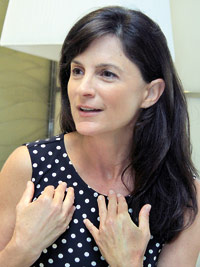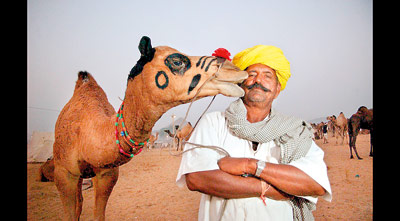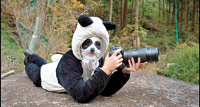Seeing a shared humanity wherever she goes

Girls in Gujarat: Children sit inside Dariya Khan Ghhumnat Rahat refugee camp set up outside a school in Ahmedabad, India
When documenting a bumper crop of captive bred pandas in China, photojournalist Ami Vitale carefully donned a panda suit soaked in panda urine to take her pictures. Bred in captivity, the animals are released into the wild when ready and the suit was necessary in order to simulate wildlife conditions. The fragrance (Perfume-du-Panda, quips Ami) were vital olfactory touches to the outfit as pandas rely on smell rather than sight. The bumper crop of pandas was hailed with delight and was no mean feat –pandas are infamously hard to breed, often show disinterest during pairings and have low rates of conception. Granted exclusive access into one of the major National Nature Reserves in China, Ami’s pictures depicted remarkable insights into the panda’s lives, their growth and the extent of care and detail taken by the programme so that the pandas can fend for themselves in the wild.
Montana-based American photojournalist and filmmaker Ami Vitale has around 94 countries stamped on her passport and has spent a considerable part of her life teasing out stories from around the world, going beyond the headlines. An introverted and painfully shy child, Ami Vitale picked up a camera at 14 and was immediately emboldened by a sense of empowerment behind the lens. As she became older, this self-empowerment matured into a heightened awareness about the power of the medium, gently nudging her onto what is her career today.

Ami Vitale: “It’s not about taking beautiful images.” Pic by Indika Handuwala
Initially working as a photo editor in New York, gazing at the stories and pictures which made its way to her desk and daydreaming of becoming a foreign correspondent, Ami quit her job and moved to the Czech Republic to do just that. The next year, the war in Kosovo began. From an amateur photographer working for a small business newspaper, Ami became an unintentional war photographer and went on to cover conflicts for nearly a decade. In her youthful passion to make an impact she took dizzying risks in reporting, travelling to dangerous locations mired in conflict. While her experience in conflict reporting and the horrors and violence witnessed left her with an intensified sense of empathy, it also took her years to recover from the trauma and post-traumatic stress.
Over the years, her work has received recognition from World Press Photo, the National Press Photographers Association (NPPA) and International Photos of the Year, and has appeared in publications such as GEO, Newsweek, Time, Smithsonian, The Guardian and the New York Times.
We meet at the lobby of a hotel in Colombo last week just as she is wrapping up her assignment in Sri Lanka for National Geographic. Her flight is later that night and our conversation is an interlude between errands – she’s about to pick up prints of some of her photographs in Sri Lanka- some of the people she photographed during her travels here have requested copies. It’s been a flurry of activity over the past weeks and a speaking engagement in the U.S. beckons at the end of a long haul flight. The only sign of fatigue however is a meditative tendency to lapse into elliptical sentences and stream of consciousness-like observations when reflecting over her work and experiences.

Man and camel - Jehal Ram and his camel at the largest camel fair in the world in Pushkar
This is her fourth visit to Sri Lanka – her first was in 2013 as a field master on ‘NatGeo Mission Cover Shot’, a reality show which had young photographers vying for a for a chance to have their picture on the cover of National Geographic Traveller Magazine. For Ami, the diversity of Sri Lanka and its gentleness had always attracted her and she relates a simple anecdote which reminded her of this. One of her first pitstops when in Colombo this time, was to a hospital to seek treatment for tick fever which she had caught during an assignment in Kenya just before. While in the foyer, she noticed that the hospital had lined up the religious symbols of all major religions in Sri Lanka and watched as a grandmother pointed out the varying symbolism behind each to her curious grandchild.
In an email just after her departure she reflects on her experience this time. “I was very lucky and amazing people opened up their lives and showed me things I never would have had access to. There was some repetition as I tried to get better images but this story is really for and about these people who shared with me. I cried today when I left and the plane was taking off […] Sri Lanka has had its fair share of misfortune but I think it’s so important to remember its greatest strength is that it has managed to preserve its soul and its warmth,” she writes.

Flooded: Ami shooting in Bangladesh
National Geographic’s progressive use of social media has been hailed as a success story of how a longstanding media organisation which dates back to 1888, emphatically embraced new media to beat out newer kids on the block. Ami’s Instagram feed (https://www.instagram.com/amivitale/) hopscotches across countries, offering glimpses of her assignments to the nearly 500,000 people who follow her. Being a photojournalist is a labour intensive career, does staying relevant on social media add to the professional pressure of keeping ahead of the game? “It is an added step in the workflow but worth the extra work. Instagram is a very effective method for reaching large audiences and getting people engaged in issues. It’s helped me get connected to interesting people who are passionate about the same issues and led to great opportunities. Instagram is one of the most powerful platforms right now to tell stories and it has completely democratised the field of photography,” she notes.
One of the toughest parts of being a photographer, she admits, is the intellectual challenges – “It takes time and trust to tell a story and get it right. And to see beyond the obvious.” For Ami, revisiting places and people helps in building layered photographs with more depth.
“What you have to remember as a photographer and frankly, as a journalist is that it’s not about you. The story is not about you and your ego and you taking beautiful images. It’s about the people we’re photographing and the stories we’re telling,” says Ami, adding that when people open up about their lives, how you tread and leave your footprints is important.With a proliferation of photographers and a hunger to get the perfect picture, sometimes,it helps to ask yourself why you are there in the first place and to treat the people you encounter with the dignity they deserve.

Playing the role: Ami, dressed as a panda, photographing pandas at Wolong National Nature Reserve, in Sichuan province, China in 2013
There’s been an overt transition from conflict journalism to wildlife, environmental and cultural stories in Ami’s photographic oeuvre. She explains that one reason was the awareness that we are deeply connected to nature and its resources and that there are pivotal issues on which the world’s future is hinged on. Another was the shared humanity which is all too easy to overlook when caught up with the despair of the world.
“I think we need to remember there is so much more that unifies us than divides us. And that’s the message I really want to send out,” she muses. “No matter where I go – even at the darkest places – I see that people are good. In that sense, journalism is a dangerous place because we can end up polarising people more and in my own country, I’m watching that happen right now and it makes me sad. People for the most part, all want the same thing. It’s important to remember we have more in common with each other than divides us. And I really want the images to speak to that.”


